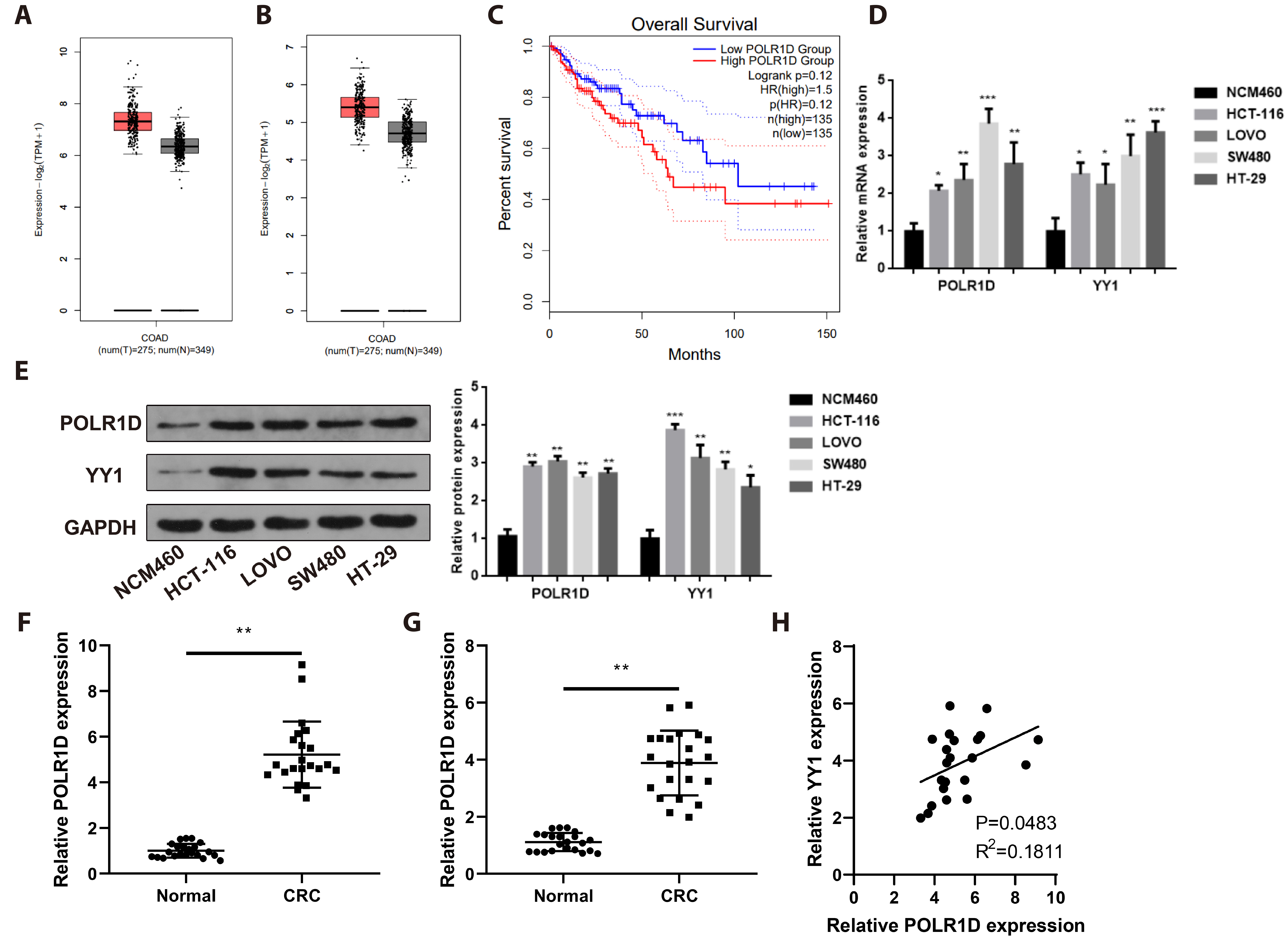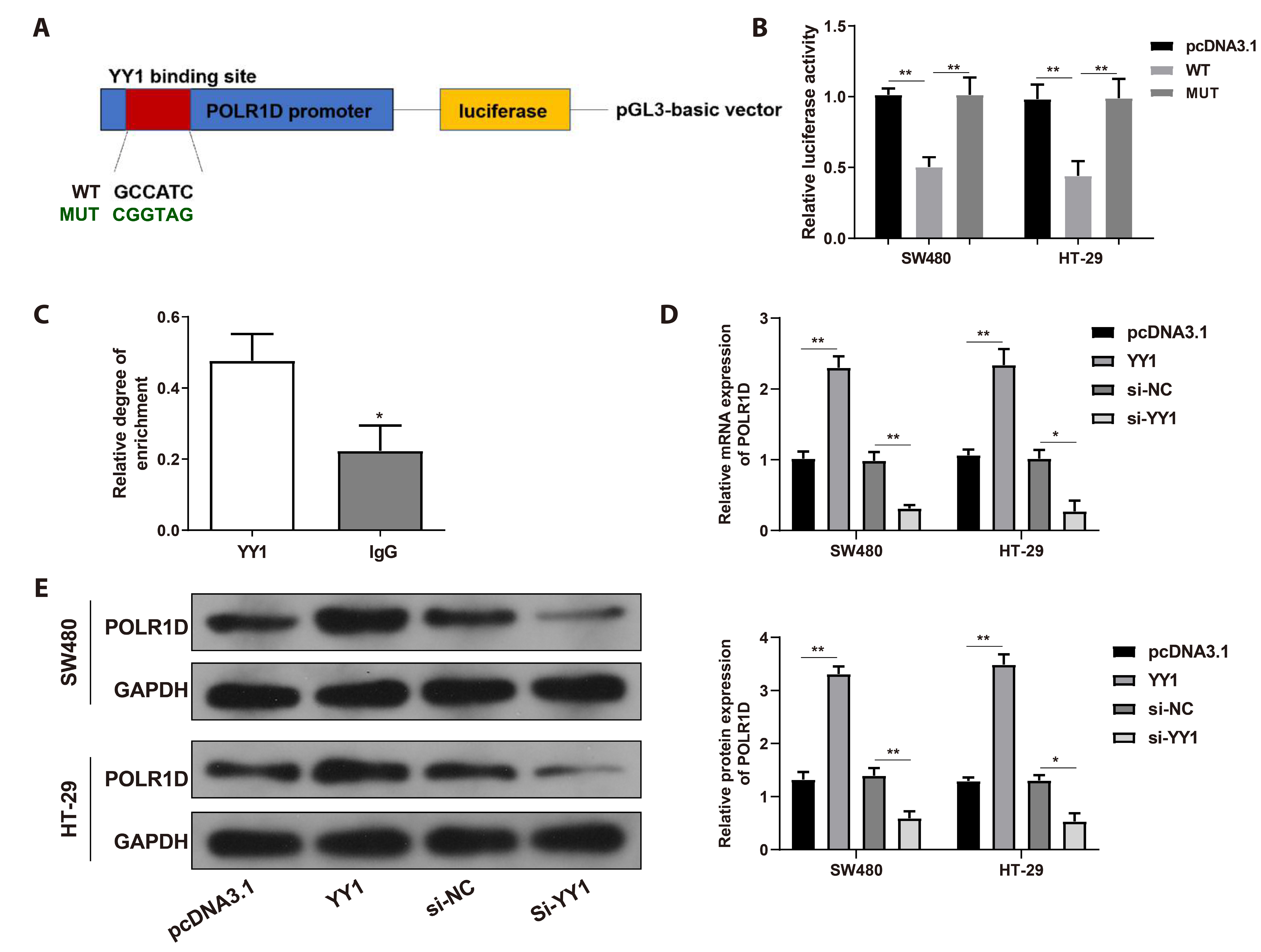Korean J Physiol Pharmacol.
2024 May;28(3):265-273. 10.4196/kjpp.2024.28.3.265.
RNA polymerase I subunit D activated by Yin Yang 1 transcription promote cell proliferation and angiogenesis of colorectal cancer cells
- Affiliations
-
- 1Department of Colorectal Surgery, Xinchang People’s Hospital, Xinchang, Zhejiang 312500, China
- KMID: 2555668
- DOI: http://doi.org/10.4196/kjpp.2024.28.3.265
Abstract
- This study aims to explore possible effect of RNA polymerase I subunit D (POLR1D) on proliferation and angiogenesis ability of colorectal cancer (CRC) cells and mechanism herein. The correlation of POLR1D and Yin Yang 1 (YY1) expressions with prognosis of CRC patients in TCGA database was analyzed. Quantitative realtime polymerase chain reaction (qRT-PCR) and Western blot were applied to detect expression levels of POLR1D and YY1 in CRC cell lines and CRC tissues. SW480 and HT-29 cells were transfected with si-POLR1D or pcDNA3.1-POLR1D to achieve POLR1D suppression or overexpression before cell migration, angiogenesis of human umbilical vein endothelial cells were assessed. Western blot was used to detect expressions of p38 MAPK signal pathway related proteins and interaction of YY1 with POLR1D was confirmed by dual luciferase reporter gene assay and chromatin immunoprecipitation (ChIP). TCGA data showed that both POLR1D and YY1 expressions were up-regulated in CRC patients. High expression of POLR1D was associated with poor prognosis of CRC patients. The results showed that POLR1D and YY1 were highly expressed in CRC cell lines. Inhibition or overexpression of POLR1D can respectively suppress or enhance proliferation and angiogenesis of CRC cells. YY1 inhibition can suppress CRC progression and deactivate p38 MAPK signal pathway, which can be counteracted by POLR1D overexpression. JASPAR predicted YY1 can bind with POLR1D promoter, which was confirmed by dual luciferase reporter gene assay and ChIP. YY1 transcription can up-regulate POLR1D expression to activate p38 MAPK signal pathway, thus promoting proliferation and angiogenesis ability of CRC cells.
Keyword
Figure
Reference
-
1. Haraldsdottir S, Einarsdottir HM, Smaradottir A, Gunnlaugsson A, Halfdanarson TR. 2014; [Colorectal cancer - review]. Laeknabladid. 100:75–82. Icelandic.2. Thanikachalam K, Khan G. 2019; Colorectal cancer and nutrition. Nutrients. 11:164. DOI: 10.3390/nu11010164. PMID: 30646512. PMCID: PMC6357054.
Article3. Dekker E, Tanis PJ, Vleugels JLA, Kasi PM, Wallace MB. 2019; Colorectal cancer. Lancet. 394:1467–1480. DOI: 10.1016/S0140-6736(19)32319-0. PMID: 31631858.
Article4. Connell LC, Mota JM, Braghiroli MI, Hoff PM. 2017; The rising incidence of younger patients with colorectal cancer: questions about screening, biology, and treatment. Curr Treat Options Oncol. 18:23. DOI: 10.1007/s11864-017-0463-3. PMID: 28391421.
Article5. McQuade RM, Stojanovska V, Bornstein JC, Nurgali K. 2017; Colorectal cancer chemotherapy: the evolution of treatment and new approaches. Curr Med Chem. 24:1537–1557. DOI: 10.2174/0929867324666170111152436.
Article6. Simard J, Kamath S, Kircher S. 2019; Survivorship guidance for patients with colorectal cancer. Curr Treat Options Oncol. 20:38. DOI: 10.1007/s11864-019-0635-4. PMID: 30937550.
Article7. Bradner JE, Hnisz D, Young RA. 2017; Transcriptional addiction in cancer. Cell. 168:629–643. DOI: 10.1016/j.cell.2016.12.013. PMID: 28187285. PMCID: PMC5308559.
Article8. Lambert M, Jambon S, Depauw S, David-Cordonnier MH. 2018; Targeting transcription factors for cancer treatment. Molecules. 23:1479. DOI: 10.3390/molecules23061479. PMID: 29921764. PMCID: PMC6100431.
Article9. Teng S, Li YE, Yang M, Qi R, Huang Y, Wang Q, Zhang Y, Chen S, Li S, Lin K, Cao Y, Ji Q, Gu Q, Cheng Y, Chang Z, Guo W, Wang P, Garcia-Bassets I, Lu ZJ, Wang D. 2020; Tissue-specific transcription reprogramming promotes liver metastasis of colorectal cancer. Cell Res. 30:34–49. DOI: 10.1038/s41422-019-0259-z. PMID: 31811277. PMCID: PMC6951341.
Article10. Wang W, Li D, Sui G. 2017; YY1 is an inducer of cancer metastasis. Crit Rev Oncog. 22:1–11. DOI: 10.1615/CritRevOncog.2017021314. PMID: 29604932.
Article11. Li Y, Kasim V, Yan X, Li L, Meliala ITS, Huang C, Li Z, Lei K, Song G, Zheng X, Wu S. 2019; Yin Yang 1 facilitates hepatocellular carcinoma cell lipid metabolism and tumor progression by inhibiting PGC-1β-induced fatty acid oxidation. Theranostics. 9:7599–7615. DOI: 10.7150/thno.34931. PMID: 31695789. PMCID: PMC6831470.
Article12. Meliala ITS, Hosea R, Kasim V, Wu S. 2020; The biological implications of Yin Yang 1 in the hallmarks of cancer. Theranostics. 10:4183–4200. DOI: 10.7150/thno.43481. PMID: 32226547. PMCID: PMC7086370.
Article13. Varum S, Baggiolini A, Zurkirchen L, Atak ZK, Cantù C, Marzorati E, Bossart R, Wouters J, Häusel J, Tuncer E, Zingg D, Veen D, John N, Balz M, Levesque MP, Basler K, Aerts S, Zamboni N, Dummer R, Sommer L. 2019; Yin Yang 1 orchestrates a metabolic program required for both neural crest development and melanoma formation. Cell Stem Cell. 24:637–653.e9. DOI: 10.1016/j.stem.2019.03.011. PMID: 30951662.
Article14. Zhang Z, Zhu Y, Wang Z, Zhang T, Wu P, Huang J. 2017; Yin-yang effect of tumor infiltrating B cells in breast cancer: from mechanism to immunotherapy. Cancer Lett. 393:1–7. DOI: 10.1016/j.canlet.2017.02.008. PMID: 28216374.
Article15. Sarvagalla S, Kolapalli SP, Vallabhapurapu S. 2019; The two sides of YY1 in cancer: a friend and a foe. Front Oncol. 9:1230. DOI: 10.3389/fonc.2019.01230. PMID: 31824839. PMCID: PMC6879672.
Article16. Chen Z, Han S, Huang W, Wu J, Liu Y, Cai S, He Y, Wu S, Song W. 2016; MicroRNA-215 suppresses cell proliferation, migration and invasion of colon cancer by repressing Yin-Yang 1. Biochem Biophys Res Commun. 479:482–488. DOI: 10.1016/j.bbrc.2016.09.089. PMID: 27663660.
Article17. Miao X, Sun T, Golan M, Mager J, Cui W. 2020; Loss of POLR1D results in embryonic lethality prior to blastocyst formation in mice. Mol Reprod Dev. 87:1152–1158. DOI: 10.1002/mrd.23427. PMID: 33022126. PMCID: PMC7686077.
Article18. Wang M, Niu W, Hu R, Wang Y, Liu Y, Liu L, Zhong J, Zhang C, You H, Zhang J, Lu L, Wei L, Xiao W. 2019; POLR1D promotes colorectal cancer progression and predicts poor prognosis of patients. Mol Carcinog. 58:735–748. DOI: 10.1002/mc.22966. PMID: 30582221.
Article19. Zhou Q, Perakis SO, Ulz P, Mohan S, Riedl JM, Talakic E, Lax S, Tötsch M, Hoefler G, Bauernhofer T, Pichler M, Gerger A, Geigl JB, Heitzer E, Speicher MR. 2020; Cell-free DNA analysis reveals POLR1D-mediated resistance to bevacizumab in colorectal cancer. Genome Med. 12:20. DOI: 10.1186/s13073-020-0719-6. PMID: 32087735. PMCID: PMC7036260.
Article20. Tian Y, Sun F, Zhong Y, Huang W, Wang G, Liu C, Xiao Y, Wu J, Mu L. 2020; Expression and clinical significance of POLR1D in colorectal cancer. Oncology. 98:138–145. DOI: 10.1159/000504174. PMID: 31722331.
Article21. Athamneh K, Alneyadi A, Alsamri H, Alrashedi A, Palakott A, El-Tarabily KA, Eid AH, Al Dhaheri Y, Iratni R. 2020; Origanum majorana essential oil triggers p38 MAPK-mediated protective autophagy, apoptosis, and caspase-dependent cleavage of P70S6K in colorectal cancer cells. Biomolecules. 10:412. DOI: 10.3390/biom10030412. PMID: 32155920. PMCID: PMC7175132.
Article22. Tang W, Zhou W, Xiang L, Wu X, Zhang P, Wang J, Liu G, Zhang W, Peng Y, Huang X, Cai J, Bai Y, Bai L, Zhu W, Gu H, Xiong J, Ye C, Li A, Liu S, Wang J. 2019; The p300/YY1/miR-500a-5p/HDAC2 signalling axis regulates cell proliferation in human colorectal cancer. Nat Commun. 10:663. DOI: 10.1038/s41467-018-08225-3. PMID: 30737378. PMCID: PMC6368584.
Article23. Zhang L, Dong X, Yan B, Yu W, Shan L. 2020; CircAGFG1 drives metastasis and stemness in colorectal cancer by modulating YY1/CTNNB1. Cell Death Dis. 11:542. DOI: 10.1038/s41419-020-2707-6. PMID: 32681092. PMCID: PMC7367849.
Article24. Park S, Han SH, Kim HG, Jeong J, Choi M, Kim HY, Kim MG, Park JK, Han JE, Cho GJ, Kim MO, Ryoo ZY, Choi SK. 2019; PRPF4 is a novel therapeutic target for the treatment of breast cancer by influencing growth, migration, invasion, and apoptosis of breast cancer cells via p38 MAPK signaling pathway. Mol Cell Probes. 47:101440. DOI: 10.1016/j.mcp.2019.101440. PMID: 31445970.
Article25. Tian L, Zhao ZF, Xie L, Zhu JP. 2019; Taurine up-regulated 1 accelerates tumorigenesis of colon cancer by regulating miR-26a-5p/MMP14/p38 MAPK/Hsp27 axis in vitro and in vivo. Life Sci. 239:117035. DOI: 10.1016/j.lfs.2019.117035. PMID: 31697952.
Article26. Kim H, Bang S, Jee S, Park S, Kim Y, Park H, Jang K, Paik SS. 2021; Loss of YY1 expression predicts unfavorable prognosis in stage III colorectal cancer. Indian J Pathol Microbiol. 64(Supplement):S78–S84. DOI: 10.4103/IJPM.IJPM_96_20. PMID: 34135143.
Article27. Yang P, Li J, Peng C, Tan Y, Chen R, Peng W, Gu Q, Zhou J, Wang L, Tang J, Feng Y, Sun Y. 2020; TCONS_00012883 promotes proliferation and metastasis via DDX3/YY1/MMP1/PI3K-AKT axis in colorectal cancer. Clin Transl Med. 10:e211. DOI: 10.1002/ctm2.211. PMID: 33135346. PMCID: PMC7568852.
Article28. Zhang N, Li X, Wu CW, Dong Y, Cai M, Mok MT, Wang H, Chen J, Ng SS, Chen M, Sung JJ, Yu J. 2013; microRNA-7 is a novel inhibitor of YY1 contributing to colorectal tumorigenesis. Oncogene. 32:5078–5088. DOI: 10.1038/onc.2012.526. PMID: 23208495.
Article29. Walker-Kopp N, Jackobel AJ, Pannafino GN, Morocho PA, Xu X, Knutson BA. 2017; Treacher Collins syndrome mutations in Saccharomyces cerevisiae destabilize RNA polymerase I and III complex integrity. Hum Mol Genet. 26:4290–4300. DOI: 10.1093/hmg/ddx317. PMID: 28973381. PMCID: PMC6251613.
Article30. Chen L, Gong X, Huang M. 2019; YY1-activated long noncoding RNA SNHG5 promotes glioblastoma cell proliferation through p38/MAPK signaling pathway. Cancer Biother Radiopharm. 34:589–596. DOI: 10.1089/cbr.2019.2779. PMID: 31657621.
Article31. Hu Z, Tie Y, Lv G, Zhu J, Fu H, Zheng X. 2018; Transcriptional activation of miR-320a by ATF2, ELK1 and YY1 induces cancer cell apoptosis under ionizing radiation conditions. Int J Oncol. 53:1691–1702. DOI: 10.3892/ijo.2018.4497.
Article
- Full Text Links
- Actions
-
Cited
- CITED
-
- Close
- Share
- Similar articles
-
- Lentivirus-Mediated Short-Hairpin RNA Targeting Protein Phosphatase 4 Regulatory Subunit 1 Inhibits Growth in Breast Cancer
- Expression of Cyclooxygenase-2 in Colorectal Cancer and Adenoma
- Upregulated Long Noncoding RNA LINC01234 Predicts Unfavorable Prognosis for Colorectal Cancer and Negatively Correlates With KLF6 Expression
- The Role of ATF3 Expression and Calcineurin Inhibition in the Putative Cancer Stem Cell Fraction of Human Cutaneous Squamous Cell Carcinoma
- LncRNA Taurine-Upregulated Gene 1 Promotes Cell Proliferation by Inhibiting MicroRNA-9 in MCF-7 Cells





